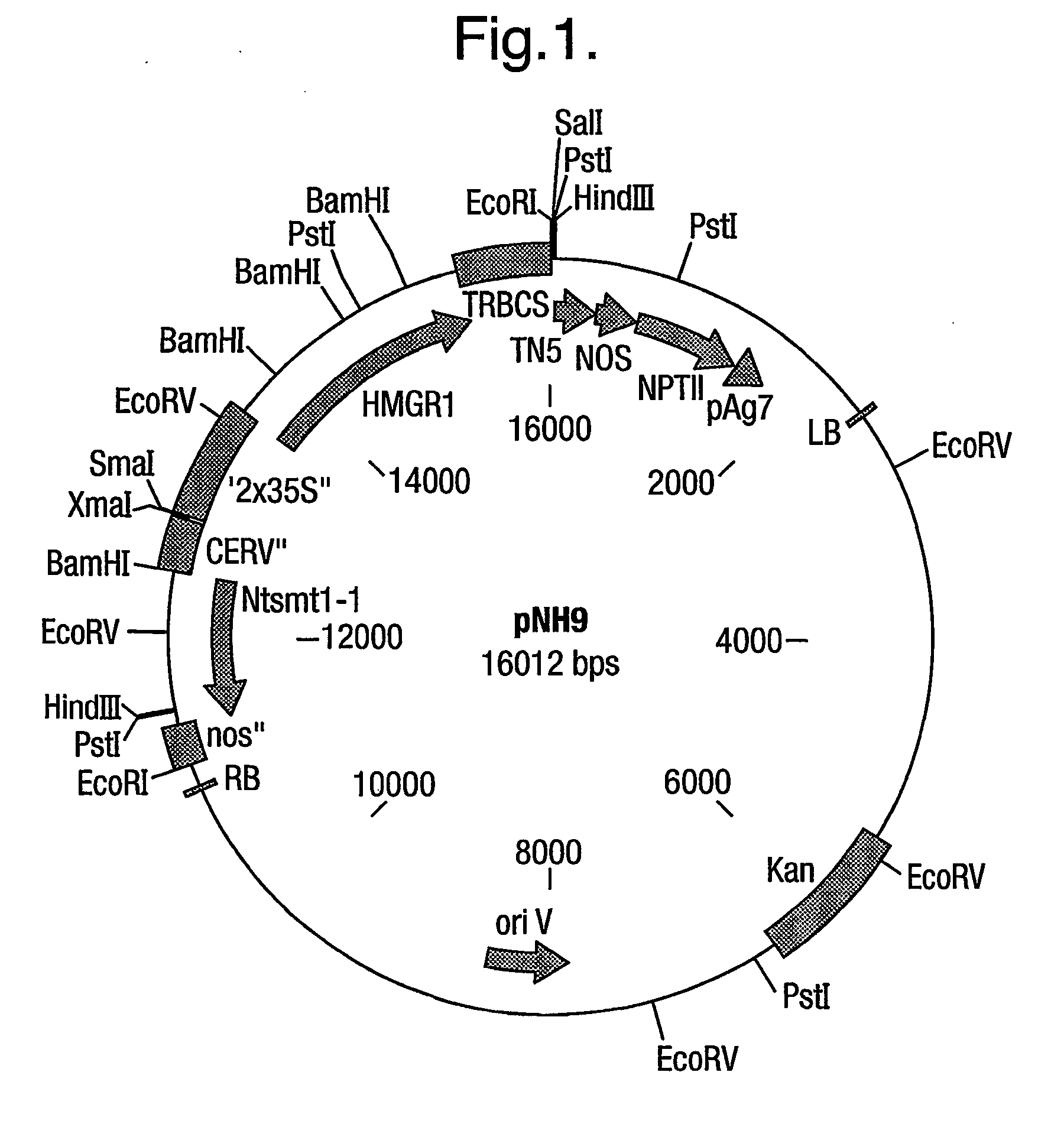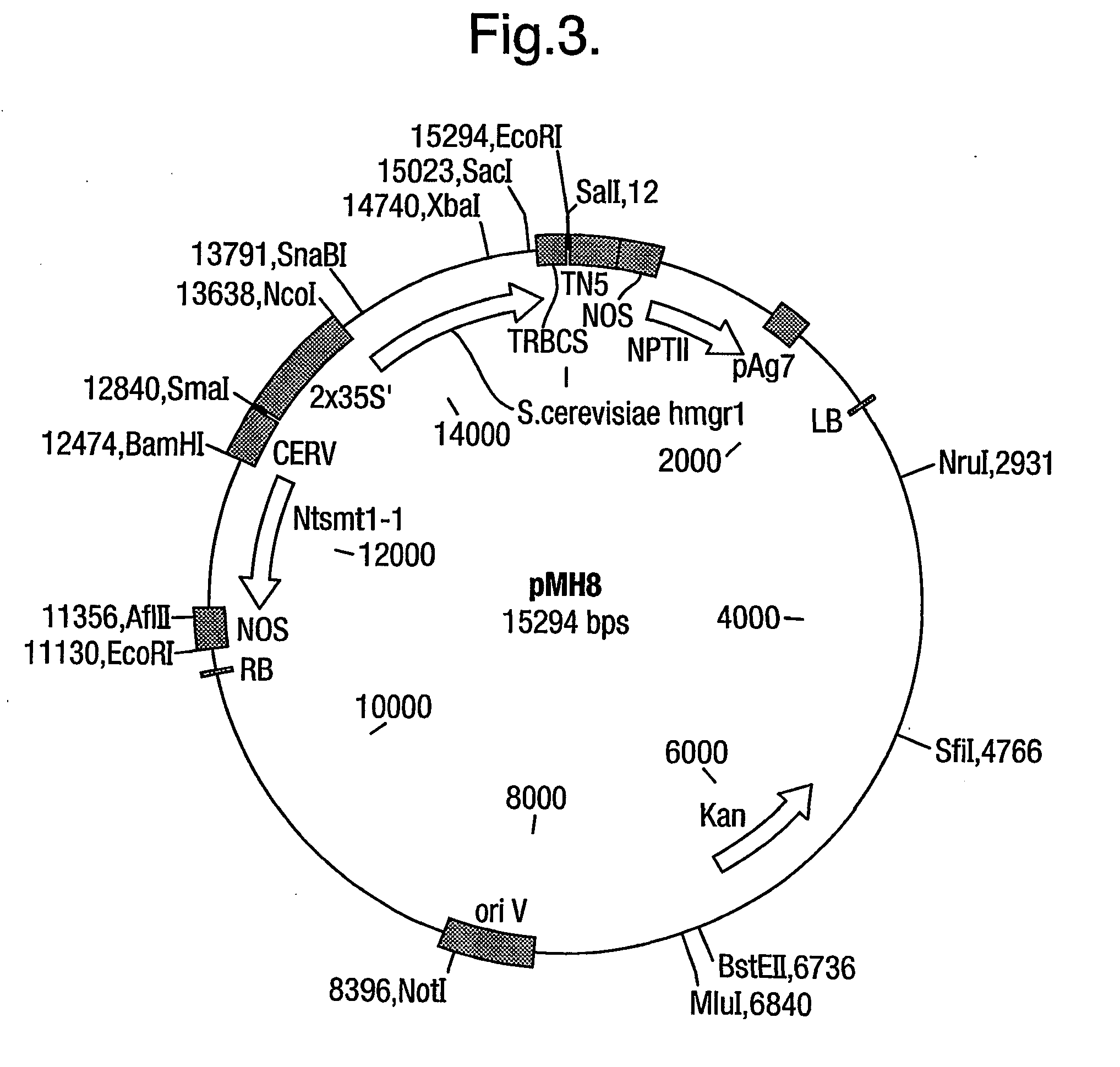Process for modifying plants
a plant and plant technology, applied in the field of plant modification, can solve the problems of non-feedback inhibition of hmgr genes, and achieve the effect of reducing cholesterol and increasing the level of sterols
- Summary
- Abstract
- Description
- Claims
- Application Information
AI Technical Summary
Benefits of technology
Problems solved by technology
Method used
Image
Examples
example 2
Co-Expression of a Truncated Form of Hevea brasiliensis hmg1 and Nicotiana tabacum SMT1 in Plants
[0069] A truncated form of Hevea HMGR, lacking the N-terminal membrane-binding domain, was cloned using the Hevea brasiliensis hmg1 as template. The Hevea brasiliensis (H.B.K.) Mull. Arg. thmg1 was cloned using the primers based on the published sequence [Chye et al (1991) Plant Mol Biol 19: 473-84]. The forward primer 5'-CCTACCTCGGAAGCCATGGTTGC-AC-3' incorporates a new start codon (bold) and a Nco I restriction site (underlined) for cloning applications. The reverse primer 5'-CATTTTACATTGCTAGCACCAGATTC-3' contains a Nhe I restriction site (underlined) for downstream sub-cloning purposes. The plasmid pNH8 was used as the template DNA in the PCR (30 cycles) using Pfu polymerase under standard conditions and produced a fragment of the expected size .about.1.3 kb. The resulting thmg1 gene codes for amino acids 153-575 of the full-length (575) hmg1 sequence (FIG. 11b of PCT / EP / 00 / 09374). The...
example 3
Co-Expression of a Truncated Form of S. cerevisiae HMGRL and N. tabacum SMT1 in Plants
[0075] Saccharomyces cerevisiae NCYC 957, X2180, SUC2 was grown in liquid media (12% (w / v) glucose, 2% (w / v) Bactopeptone, 1% (w / v) yeast extract, pH 4.0) on a rotary shaker (125 rpm), at 30.degree. C. Cells were harvested by centrifuging 50 ml of culture at 4,500 rpm for 10 minutes. To the cell pellet, 4 ml of buffer (50 mM Tris-HCl, pH 8.0, 200 mM NaCl, 100 mM EDTA, 1% SDS) was added and heated at 60.degree. C. for 15 minutes. 40 .mu.l RNase (1 mg / ml) and 40 mg Proteinase K were then added to the mixture prior to heating at 50.degree. C. for 15 minutes. The DNA was extracted twice with phenol / chloroform and once with chloroform. The aqueous layer was added to 0.7 volumes of isopropanol and 3 M sodium acetate, pH 5.2, incubated at room temperature for 1 minute and centrifuged at 13,000 rpm for 10 minutes. The supernatant was removed and 500 .mu.l 70% ethanol was added to the DNA pellet and re-cent...
example 4
Re-Transformation of ACP--Ntsmt-1 Transgenic Tobacco Plant #27 with an N-Truncated Form of Hevea HMGR Gene Driven by a Constitutive Promoter
[0079] Nicotiana tabacum plants (NH19 series) transformed with the N. tabacum Ntsmt-1 gene (SMT1) were generated as described in EP 00303193.7. Seeds from NH19 plant #27 EP 00303193.7 were germinated on MS agar containing 25 mg / L hygromycin. From the resulting seedlings, leaf segments were cut and transformed with a 2.times.35S--truncated Hevea brasiliensis HMGR construct (MH 5, PCT / EP / 00 / 09374) as described hereabove.
[0080] Table 7 shows the sterol analysis of mature seed obtained from NH19 #27 tobacco plants transformed with the MH5 construct and expressing the tobacco SMT1 and truncated H. brasiliensis HMGR genes. Seeds from 24 independent transgenic plants were analysed along with seeds from 5 SR1 control plants, 4 plants grown from NH19 #27 seed and 10 vector control plants (SJ34 into NH19#27). The total sterol content of the SR1 plants ran...
PUM
| Property | Measurement | Unit |
|---|---|---|
| Fraction | aaaaa | aaaaa |
| Fraction | aaaaa | aaaaa |
| Fraction | aaaaa | aaaaa |
Abstract
Description
Claims
Application Information
 Login to View More
Login to View More - R&D
- Intellectual Property
- Life Sciences
- Materials
- Tech Scout
- Unparalleled Data Quality
- Higher Quality Content
- 60% Fewer Hallucinations
Browse by: Latest US Patents, China's latest patents, Technical Efficacy Thesaurus, Application Domain, Technology Topic, Popular Technical Reports.
© 2025 PatSnap. All rights reserved.Legal|Privacy policy|Modern Slavery Act Transparency Statement|Sitemap|About US| Contact US: help@patsnap.com



